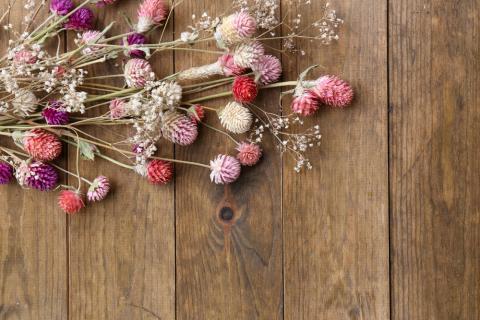
Do you have an herb or flower garden? Do you enjoy foraging for flowers and herbs? Learning how to properly harvest and dry plants can really help them last a while and preserve their flavor and beneficial properties.
How To Harvest Flowers & Herbs
First up, it’s important to know when the ideal time to collect flowers and herbs are. Ideally, you should set out to collect them on a sunny day, particularly after the morning dew has evaporated, but the midday sun isn’t out in full force. It’s okay to harvest throughout the day too, if that timing doesn’t work out for some reason, but these are the ideals.
Make sure to look for flowers and leaves that aren’t wilted and don’t have insect damage or brown spots. You want to choose the most beautiful, vibrant looking plants for this. Just snip them off and collect only the parts you wish to dry out. It’s easier to collect a whole flower head than the individual petals, as a general rule. Use gardening shears, your hands, or scissors to get the job done—just make sure the cut is as clean as possible. You can use a glass jar or a wicker basket to hold all your harvested plants.
Best Flowers & Herbs For Harvesting
- Chamomile
- Rose
- Calendula
- Lavender
- Cornflower
- Dandelion
- Elderflower
- Lemon balm
- Lilac
- Plantain
- Violets
- Mint
- Sunflowers
- Hollyhock
How To Dry Flowers & Herbs
Once you’ve gathered a sufficient number of flowers and herbs, bring them inside and be ready to tend to them right away. If you have to run out and you can’t dry them for several hours, I recommend placing the herbs and flowers in your fridge with a damp paper towel over the top of them to keep them fresh.
There are certain flowers that can be dried whole, like chamomile, dandelion, lavender, and calendula. The petals from larger flowers, like hollyhocks and roses, should be separated from the head before drying. If you have small rosebuds, you can make an exception to this rule. They can be dried whole, just as long as you turn them a few times a day so one side doesn’t dry flatter than the other.
Flower clusters, like lilacs and elderflowers, can be dried upside down on a towel to preserve some of the shape. Small branches of leaves that easily lay flat when placed on a surface (like elder leaf), can stay together while drying. However, leaves that cluster together, like mint and lemon balm, do best if you detach each leaf before drying.
- Choose an area in your house with good circulation to do this, and where the plants won’t get disturbed or exposed to lengthy stretches of direct sunlight. Indirect sunlight is more than okay though. The best place to do this is any empty spots on your counters, or the kitchen table.
- To begin the drying process, spread your herbs and flowers out in a single layer over a clean dish towel or multiple paper towels. Avoid piling the plants on top of each other, but it’s okay if a few petals overlap every so often. You don’t want them to start self-composting!
- Check on how everything is drying once or twice a day. Turn individual pieces so they dry evenly on both sides. If you own a dehydrator, it’s also a great way to dry herbs if you’re in a hurry. Just follow the manufacturer’s directions and dry on the lowest heat setting, making sure to check in every hour or so.
- You’ll be able to tell when an herb or flower is completely dry if you rub a piece between your fingers and it feels crisp and crumbles easily. If it still feels moist or too pliable, try drying it longer.
- Once completely dry, you can store your herbs and flowers in brown paper bags or clean glass jars.
Here are some more tips to remember when drying herbs and flowers:
- For a long shelf life, be sure to keep dried herbs and flowers out of direct sunlight and in a non-humid area.
- Don’t crush or powder them until ready to use them, as this helps preserve the aromatic essential oils in the plant. It will help extend freshness as long as possible. If you do this, your dried herbs and flowers should be useable for 9 months to a year.
- Just remember, as color fades on flowers and leaves, so does potency. Herbs that are dull and colorless are past their prime. The best thing to do with them is compost them!
To use your dried herbs, here are several healthy uses for herbs to give a try. How will you use your dried herbs and flowers?








